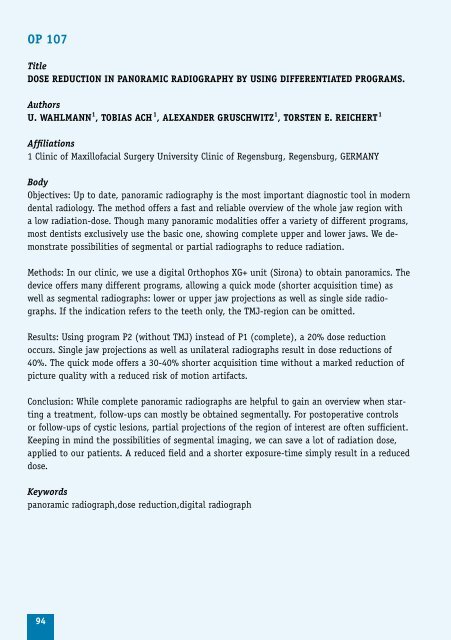Program including abstracts as pdf available here
Program including abstracts as pdf available here
Program including abstracts as pdf available here
Create successful ePaper yourself
Turn your PDF publications into a flip-book with our unique Google optimized e-Paper software.
OP 107<br />
Title<br />
DOSE REDuCTION IN PANORAMIC RADIOGRAPHy by uSING DIFFERENTIATED PROGRAMS.<br />
Authors<br />
u. WAHLMANN 1 , TObIAS ACH 1 , ALEXANDER GRuSCHWITz 1 , TORSTEN E. REICHERT 1<br />
Affiliations<br />
1 Clinic of Maxillofacial Surgery University Clinic of Regensburg, Regensburg, GERMANY<br />
Body<br />
Objectives: Up to date, panoramic radiography is the most important diagnostic tool in modern<br />
dental radiology. The method offers a f<strong>as</strong>t and reliable overview of the whole jaw region with<br />
a low radiation-dose. Though many panoramic modalities offer a variety of different programs,<br />
most dentists exclusively use the b<strong>as</strong>ic one, showing complete upper and lower jaws. We demonstrate<br />
possibilities of segmental or partial radiographs to reduce radiation.<br />
Methods: In our clinic, we use a digital Orthophos XG+ unit (Sirona) to obtain panoramics. The<br />
device offers many different programs, allowing a quick mode (shorter acquisition time) <strong>as</strong><br />
well <strong>as</strong> segmental radiographs: lower or upper jaw projections <strong>as</strong> well <strong>as</strong> single side radiographs.<br />
If the indication refers to the teeth only, the TMJ-region can be omitted.<br />
Results: Using program P2 (without TMJ) instead of P1 (complete), a 20% dose reduction<br />
occurs. Single jaw projections <strong>as</strong> well <strong>as</strong> unilateral radiographs result in dose reductions of<br />
40%. The quick mode offers a 30-40% shorter acquisition time without a marked reduction of<br />
picture quality with a reduced risk of motion artifacts.<br />
Conclusion: While complete panoramic radiographs are helpful to gain an overview when starting<br />
a treatment, follow-ups can mostly be obtained segmentally. For postoperative controls<br />
or follow-ups of cystic lesions, partial projections of the region of interest are often sufficient.<br />
Keeping in mind the possibilities of segmental imaging, we can save a lot of radiation dose,<br />
applied to our patients. A reduced field and a shorter exposure-time simply result in a reduced<br />
dose.<br />
Keywords<br />
panoramic radiograph,dose reduction,digital radiograph<br />
94


